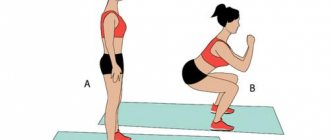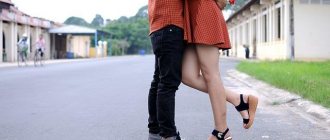Step platform exercises are currently gaining popularity.
A step platform is a fitness machine that helps you lose extra pounds, tone your muscles and improve your heart function. Classes on a step platform involve dance movements with music. In order to engage in this type of fitness, you do not need a lot of space. Turn on rhythmic music and do the following exercises.
Attention, exercises on the step platform have a number of contraindications, consult your doctor!
Exercise 1 – Basic Step
This exercise is similar to walking up stairs.
- Step one foot onto the step platform, then the other, and lower yourself in the same order.
- After 3-5 minutes, change legs. The exercise is done at a fast pace.

The next version of Basic-step is complicated:
- Stand directly in front of the step platform, hands on your waist.
- Step your left foot onto the platform, raising your left arm to your right shoulder, then lower your leg first, then your arm, and repeat this exercise with your right leg and right arm.
After you get used to this exercise, you can complicate the task with dumbbells or weights.
Quick, effective compound exercises with dumbbells
All these exercises can be easily combined into one quick and effective workout, and you can also remove or add exercises to suit your taste and capabilities. The training program must be designed correctly, taking into account the pace and lifestyle. These are great full body exercises to do at home with dumbbells.
I am sure that you will feel the effect of the workout in burning calories not only during it, but also the next day, because I have collected the most effective exercises with dumbbells for you.
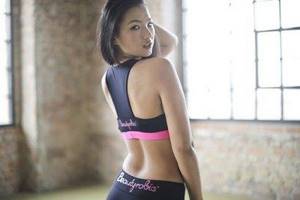
Thanks to the rhythm and simplicity of movements, step aerobics has become a popular activity for beginners and experienced athletes.
This is a great way to keep fit and achieve your desired figure.
In this article we will analyze the basic steps, features of classes and examples of training programs in this direction.
Exercise 2 – Step-up
The exercise is not difficult, it can be performed between intense movements, allowing some muscle groups to rest.
- Place your right foot on the step platform, then your left foot on your toes and lower your left first, then your right.
- The exercise with one leg is performed for three to five minutes, after which the leg is changed.

During the exercise, keep your body straight, do not bend over, take a step with your foot with your full foot. Make sure your heel doesn't hang down.
How to choose dumbbells
Dumbbells can be collapsible or non-collapsible. The latter have a given weight. Collapsible ones consist of a bar and a set of plates. If you plan to do strength training and gradually increase the load, buy collapsible equipment: they take up little space and allow you to select the weight for each exercise.
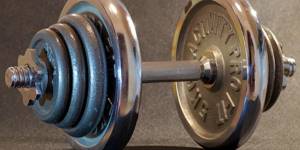
Collapsible dumbbells
You can buy non-separable ones, but take several weights at once for exercises on different muscle groups. For shoulders, biceps and triceps you need light dumbbells up to 5 kg. For squats, deadlifts and other exercises for large muscle groups, equipment weighing at least 16–20 kg is suitable.
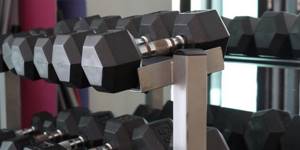
Non-separable dumbbells
You can also find fitness dumbbells coated with neoprene or vinyl in stores. They are bright and pleasant to the touch, but are too light for strength training and are only suitable for aerobic exercise sessions.
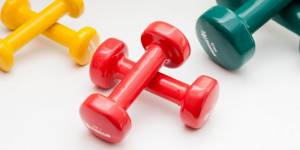
Dumbbells for fitness
Therefore, even if you are a complete beginner, do not take these dumbbells for strength training. As a last resort, you can always fill a plastic bottle with sand or water and get the same 1.5–2.5 kg.
Exercise 4 – Basic-over
Starting position - feet shoulder-width apart.
- You begin the movement of your right leg, lifting it onto the platform, and place your left leg towards it.
- We lower ourselves from the platform to the other side with our right foot, then with our left.
- We turn the body and make a similar movement.
- Return to the starting position and repeat the movement for a few more minutes. You need to do this movement from 8 to 10 repetitions.

When performing the exercise, you don’t have to go down from the platform, but jump off - do it as you feel comfortable.
To complicate the task, you can perform the exercise diagonally or on the other side of the platform, which is narrower.
Variations of exercises on the step platform
A step aerobics class is a set of choreographic movements accompanied by music and designed to train the muscles of the lower and upper body, as well as the cardiovascular system.
Regular exercise will provide several benefits:
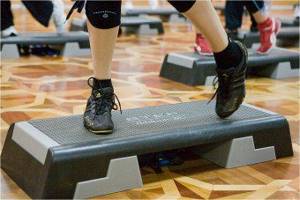
- improve heart function, increase endurance;
- strengthen the leg muscles, making every step easier;
- Maintain a healthy weight to prevent diabetes, heart disease and joint pain.
Basic steps are the basis of step aerobics, giving scope for creating workout combinations. Before you sign up for a group class for the first time, it will be helpful to familiarize yourself with the steps. For beginners, separate first-level step aerobics classes have been created, where the sequences are as simple as possible for memorization and execution.
Exercise 5 - for the hips
This exercise is aimed at working the thigh muscles.
- Stand to the side of the platform so that you are facing away from it.
- Step forward, jump with both feet, then jump back to the platform.
- Next, try to jump onto the platform with both feet and come down from it on the other side. Repeat the same movements: step, jump, step back to the platform, jump onto the platform and then jump off the platform.

Do this exercise for three to five repetitions on each side.
To make the exercise more difficult, perform the movement with slightly bent legs or with a more intense load.
Exercise 6 - maximum load on the legs
The exercise is suitable for those who have high endurance, as it uses a platform with maximum height.
- First you need to stand sideways to the step platform.
- Jump on it with both feet and jump again around your axis.
- During the jump, it is recommended to make as many turns as possible to the starting position - first in one direction, then in the other.
- Beginners are allowed to make four turns, then three and two.

After you have mastered this exercise, do jumping jacks on the platform on one leg, then on the other.
Do the exercise without distractions, carefully!
Exercise 7 - intensive for legs
This exercise must be performed intensively.
- To begin, stand on the step, put your hands on your waist.
- Jump with one foot to the floor, come back, jump with the other foot and come back.
- When performing this exercise, you need to jump as high as possible.

If the step platform is low for you, then perform it on a higher one.
Before jumping, make sure the floor is not slippery to avoid slipping and injury!
Lunges: advantages of execution and main mistakes
The lunge exercise has a number of benefits, so be sure to include it in your training plan if you want to work on the muscles of your legs and buttocks. This exercise is especially useful for girls who, as a rule, prefer to train their lower body especially carefully.
Benefits of performing lunges:
- Lunges are an ideal exercise for the glutes and quadriceps.
- The exercise is quite physiological because it imitates a walking pattern.
- Unlike squats, lunges are very effective in correcting muscle imbalances.
- Thanks to lunges, you can not only increase muscle mass, but also stretch and lengthen muscles, leaving your legs dry and toned.
- Lunges with dumbbells or a barbell are much safer for your back than squats.
- This exercise has many modifications depending on your goals and capabilities.
- You can easily perform the lunge exercise even at home without additional equipment.
- Lunges allow you to work out your inner thighs, which is especially important for girls.
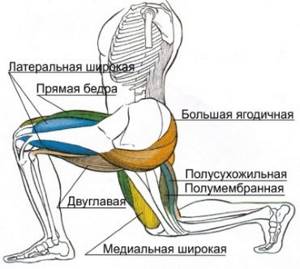
Lunges: what to look for
Let's take a closer look at the main mistakes that trainees make when performing lunges. In order to avoid repeating these mistakes, it is better to perform lunges in front of a mirror, at least for the first time, and carefully monitor the correct technique.
Basic mistakes when performing lunges:
- The knee goes forward of the toe or to the side (this puts a traumatic load on the knee joints).
- The body goes forward, the back is hunched, the shoulders are on the ears (this takes the load off the gluteal muscles and puts extra stress on the spine).
- The thighs and shins of both legs do not form a 90-degree angle (this reduces the load on the muscles and increases the load on the knee and ankle joints).
- Widely spaced legs (this leads to loss of stability and balance during the lunge exercise).
Incorrect execution of lunges:
Correct execution of lunges:
What are the dangers of performing lunges incorrectly:
- Pain in the knee joint
- Pain in the ankle joint
- Pain in the back and lower back
- Ineffective load on muscles
If you have chronic problems with your knee joints, then it is better not to perform the lunge exercise. Check out our selection of leg and butt exercises that you can do on the floor that are safe for your knees.
Exercise 8 - Jumping
- Stand in front of the step platform (narrow side).
- Start the movement with your right foot. Raise your leg onto the step, then the other, then jump to the floor so that the step is between your legs.
- Then you jump again and jump to the floor again.

Repeat this exercise several more times.
To make it more difficult, add arms and increase the intensity of the exercise.
Exercise 9 - Leg Stretch
- Stand with your back to the step platform, take a step back with your right foot, and place your other foot on the platform.
- Place your hands on your belt, your back should be straight.
- Begin to lower your back leg down. It is necessary to bend the leg so that an angle of 90 degrees is formed from the shin to the knee.

Repeat about 10 reps on each leg in 3 sets.
Lunges forward
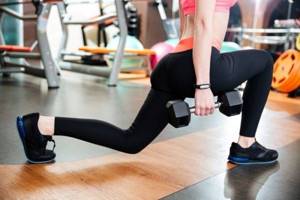
As you inhale, take a wide step forward with one leg (hereinafter we will consider it your working leg). Keeping your torso straight, transfer your center of gravity to your forward leg and squat down on it deeply until the thigh of your working leg is parallel to the floor (attention! Going lower, as well as touching the floor with your knee, is dangerous for your knee joints!). Check yourself - at the bottom point of the exercise: - the shin of the front leg is strictly vertical - the working leg is bent at the knee at a right angle - the knee of the working leg is directly above the ankle and does not protrude forward (if the knee “sticks out” beyond the toe of the foot, this threatens injury to the knee joint ) - the muscles of the back of the thigh of the working leg and buttocks are stretched like strings - the knee of the hind leg “hangs” a few centimeters above the floor (but does not touch it!) Return to I.P.
The most important thing about lunges is the correct rise from the squat. You need to rise ONLY using the isolated force of your forward leg. Don’t even try to help yourself by pushing off the floor with your other foot! You will be tempted to lean forward to make things easier for yourself - resist! To do this, shift the center of gravity of the body back, pushing the torso back. At the same time, you will feel a shift in the load on the heel of the working leg.
Only from this position can you begin to rise. The body should remain straight, as if you had swallowed a huge ruler! As you rise to the starting position, remember to exhale (remember the basic principle: exhale during the effort?). First do 8-12 repetitions (steps) with one leg, then the same number (without rest) with the other.{banner_st-d-1}
Possible variations of forward lunges:
No. 1. One variation of this exercise is alternating lunges. Take turns first taking a step with your right foot, then taking a step with your left foot. The total number of lunges should be even - 20-30 times.
No. 2. You can perform the same exercise not with dumbbells, but with a bar or barbell, which you need to place on your upper trapezius and grab the bar with an overhand grip wider than your shoulders. This, of course, makes it more difficult to maintain balance. However, dumbbells overload the shoulders and hands, and they can simply slip out of them due to fatigue. You just need to hold the barbell on your shoulders.
No. 3. Another option: when returning to the starting position, do not lower your front leg to the floor, but pull it to your chest, and only then place it on your supporting leg.
No. 4. The next “advanced” option is walking with lunges. For this exercise you will need space. There are two types of this exercise: after each step, you can put your back foot next to your working leg; You can immediately step forward with your back foot. The second option is more difficult, since you will not have a second of rest between repetitions, but the load on your legs will be maximum. Walking lunges are usually done in series of ten. Perform 10 steps in one direction, then 10 steps in the opposite direction. You can also hold the bottom position for a second to increase the load. And remember that you cannot rise from a squat with a sharp pushing force!
No. 5. Many people get so carried away with legwork that they completely forget about the buttocks. To fully experience the exercise through “that spot,” try statically straining them at the top point of the exercise or, even better, maintaining tension at the “fifth point” throughout the range of motion.
No. 6. When you have no strength at all, you can lower yourself into a squat and spring on your working leg until the muscles are completely tired.
BACK LUNCHES (reverse lunges).
Back lunges can be done with either dumbbells or a barbell. The starting position is the same as for forward lunges. Take a step back and slowly lower yourself down. The length of the “reverse” step should be such that the part of the front leg from the knee to the foot is strictly at a right angle to the floor (this position puts the knee in the safest anatomical position. If you step back too far, the knee of the other leg will be half-extended. A this is dangerous if you have dumbbells in your hands). The torso should be slightly tilted back so that the weight of the body falls on the heel of the working leg. Feel how your buttocks tighten as you move. At the bottom point, when the shin is vertical, pause for a second. In this case, the back leg stands on the toe, and its knee almost (!) touches the floor. Then, by pushing the heel of your FRONT leg, return to the starting position. Attention! Lifting up by pushing from the back leg is a mistake!
Possible Reverse Lunge Variations #1: You can perform backward lunges with one foot on a raised platform (such as a step platform). Make sure the platform is stable in advance. Be sure to keep your torso straight and do not allow yourself to lean forward! No. 2. A more complicated option is reverse lunges on a platform with knee lift. To do this, place your foot on the step and take a squat position so that the toe of your back foot rests on the floor. Straighten the muscles of your working leg with effort, but do not place your back leg on the platform, but perform a swing movement with it, raising your knee high. And only then place it on the platform. Repeat as many times as necessary for each leg.
SIDE LUNCHES with dumbbells (lateral lunges)
Another type of lunge, where the main emphasis is on the inner thighs and biceps of the legs. This exercise can also be performed with either dumbbells, a barbell, or a barbell. The starting position is the same. If you do lunges with dumbbells, it is most convenient to hold them at your shoulders. Take a wide step to the side with your left foot and squat down so that your right thigh is almost parallel to the floor and your right leg is straight. The farther you move your leg, the greater the load on the thigh muscles and the less on the knee joint. It is very important not to lift your right foot off the floor. Keep your body straight, do not tilt it! Stay in this position for a couple of seconds. Then, using the strength of the muscles of your left leg, return to the starting position. Here you can also vary the load: either do the required number of lunges with one leg and then move on to the second, or perform alternating lunges on the right and left sides.
CROSS LUNCHES.
It combines forward and reverse lunges and requires a certain level of fitness and endurance, so is not suitable for beginners. I recommend performing criss-cross lunges with dumbbells, using weights that are slightly lighter than your normal working weights. The starting position is the same. The technique is as follows: 1.1. -1.2. Step your right foot forward. Return to IP. 2.1. -2.2. Step your left foot back. Return to IP. 3.1. -3.2. Step your left foot forward. Return to IP. 4.1. -4.2. Step your right foot back. Return to IP. And repeat the whole cycle again (several times). With this execution, each hip works 2 times in a row, and only then does the working leg change.
BULGARIAN LUNCHES.
This exercise is performed with dumbbells near a gymnastic bench, chair or any other support 30-40 cm high (at knee level), located behind the back. A fitball is also suitable for these purposes. Starting position - standing, straight arms on the belt (light version) or with dumbbells lowered along the body. If you want to make the exercise even more challenging, pick up a dumbbell or a weight plate and extend the weight in front of you. Stand with your back to the support and place your right leg on it (with your leg bent at the knee). Bring your left leg forward as far as possible. Keeping your torso still, bend your supporting leg at the knee, lowering into a deep lunge (to a 90-degree angle, with your front thigh parallel to the floor). Return to the starting position. Perform the required number of repetitions and change your working leg.
Exercise 10 - with hand support
To perform this exercise, you need to stand to the side of the platform.
- One foot must be placed on the platform. Legs should be parallel to each other.
- Transfer your body weight to the leg that will carry the main load. Pull your pelvis back.
- Use the hand closest to the platform to lean on it and jump to the other side.
- Then you need to change your leg and repeat this exercise.

Exercise 11 - V-step
This exercise is performed with intense load.
- Stand directly in front of the step platform, feet shoulder-width apart.
- Start the exercise with your right foot. Raise your right leg to the right corner of the platform, then your left leg to the left corner, then lower your right leg, then your left.
- When performing the exercise, your toes should point towards the sides of the platform and resemble the letter V.
- Perform the exercise for several minutes and repeat on the other leg.
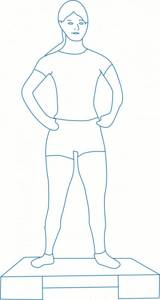
Correct exercise technique
Joint gymnastics are suitable for warming up:
- perform rotations of the head, arms, shoulders, hip and knee joints;
- make all kinds of tilts;
- Running in place with high legs and jumping in place or with a skipping rope will also not hurt.
First, you should learn how to properly do lunges without weights in the classic version.
- Feet shoulder-width apart parallel to each other.
- Keep your back straight.
- The gaze is directed forward.
- Hands on hips.
- Head and back in the same plane.
- Shoulders are separated.
- Take a couple of deep breaths in and out.
- While inhaling, step forward with one leg.
- Keep your body perpendicular to the floor.
- Shift your body weight to your front leg.
- The leg in front rests on the entire foot.
- The foot is back only on the toes, the heel looks up.
- The knee of the back leg almost touches the floor.
- Keep both knees at right angles.
- Pull in your stomach.
- Stretch the top of your head up.
- Spread your shoulders and lower them down.
Return to starting position:
- As you exhale, transfer your body weight to your back leg.
- Extend your supporting leg and stand in the starting position.
While inhaling, perform the exercise with the other leg.
Other lunge options:
- Lateral (to the side) - engages the adductor and abductor muscles of the thighs;
- Reverse lunges (back lunges) are actually no different from classic ones;
- Bulgarian (with your back to the support on which the leg rests, resting on the instep) - first, all repetitions are performed on one leg, then on the other;
- Walking with lunges maximizes the use of stabilizing muscles and develops coordination.
You can also divide the technique into lunges with return (stomping on the spot) and walking with lunges. When walking, it is advisable to use an extended step, otherwise there is a high risk of losing balance, falling and injury.
When performing any version of the exercise, you should follow the general recommendations, relying on the technique of performing classic lunges.
General recommendations
- Keep your feet shoulder-width apart to avoid falling face down.
- Fix your lower back.
- Always look forward in front of you, do not lower your chin.
- The stomach does not touch the supporting leg.
- At first, you can use support - hold on with your hand.
- It is necessary to increase the load gradually.
It is recommended to perform at least 8 lunges with each leg to sufficiently engage the gluteal muscles.
An acceptable number of approaches is from 3 to 5.
Lunges with dumbbells and a barbell are a great complement to squats, Roman deadlifts and leg training on a machine, but they allow you to work more stabilizing muscles and achieve harmonious development faster.
With dumbbells
If you have mastered the technique of performing classic lunges, you can begin performing the exercise with dumbbells.
It is believed that proper execution of lunges with dumbbells as weights is more suitable for women.
There are two options for performing the exercise.
First: classic - arms with dumbbells are extended along the body, which makes it easier to maintain balance.
Second: dumbbells in bent arms on the shoulders. The technique is the same as with a barbell and it is more difficult to maintain balance.
Tip: turn your toes slightly inward, and hold the dumbbells with your entire hand.
With a barbell
It is believed that lunges with a barbell on the shoulders are more suitable for men - with this placement of the weight, the core stabilizer muscles are stronger.
The technique is the same as with dumbbells, but it requires a lot of concentration - you won’t be able to get rid of the barbell during the exercise like you would with dumbbells if something goes wrong. It is necessary to monitor your breathing and do the exercise without jerking. When performing, look forward, not down.
In Smith
The quadriceps muscle of the thigh is well worked out when performing lunges in the Smith machine. Exercise not only pumps up the muscle, but also improves strength. Used in training by bodybuilders, powerlifters and other athletes.
The pace is slow with a high number of repetitions.
Thanks to the use of the simulator, the load on the spine is reduced.
Performing lunges on a Smith machine:
- Considering the possibility of displacement when performing the exercise, it is convenient to position the bench (you don’t have to use an elevation, but with it the load on the supporting leg is higher).
- Using a close grip, grab the bar and place it on the top of your trapezius.
- Bend your back in the lumbar region. The buttocks should be at such a level that the knee forms a right angle.
- When bending your leg, you need to make sure that your knee does not protrude beyond your toe.
- The body weight is in the heel of the working leg, the foot of which does not leave the floor.
- Appropriate shoes with flat soles.
- The knee and toe point in the same direction.
- Breathing is deep.
Exercise 12 - to stretch the thigh muscles
This exercise will help you warm up your thigh muscles - both before and after a fitness class.
- To do this, you need to stand facing the step platform. Place one leg on it and shift the center of gravity of your body, bending and unbending the other leg.
- Change your leg.

It is recommended to perform this exercise for 3-4 approaches on each side.
Warm up before the main workout
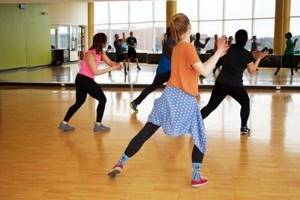
Warm-up is necessary for high-quality warming up of muscles, proper preparation of joints for intense exercise: it reduces the risk of possible injuries and discomfort after training.
The warm-up plan should be based on basic exercises:
- Bends and head rescue movements to warm up the neck muscles.
- Bend the torso to tone the muscles of the back and abs.
- Rescue movements of the arms to warm up the shoulder muscles and joints.
- Raising the body at a slow pace from a lying position to prepare the lower back.
- Running (possibly on the spot) at different speeds to accelerate blood circulation and heart contractions, warming up the leg muscles.
- Jumping rope to increase blood flow throughout the body and warm up all muscles.
Exercise 13 - lying on the platform
At this stage of the exercise, twisting is performed, so before performing, adjust the platform: on one side, put it on the third level, and on the other, on the very first level.

- Lie with your back on the step so that your head is at the first level.
- Place both feet on the platform, cross your arms at your chest and lift your torso 20 times slowly and 10 times quickly. If performing such an exercise is difficult, then reduce the number of times to 10.
- You need to perform twists in 3 sets; when lifting your torso, twist and exhale.
- Then rest and perform side crunches in the same way.
Pros and cons of this type of fitness for beginners
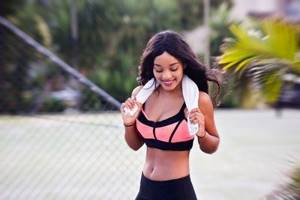
Useful characteristics:
- A set of exercises based on basic steps helps you quickly burn excess calories and reduce subcutaneous fat.
- Strengthens the heart muscle and improves blood circulation.
- Exercises on the stepper are useful for the muscles of the back, arms, buttocks and legs - they form beautiful posture and a slender silhouette.
- Improves motor coordination, developing dexterity and flexibility.
- It is possible to easily adjust the load level using tempo and various motor elements.
- Exercises on a stepper without weights or with dumbbells can be practiced not only in a fitness club, but also at home.
- Step aerobics can be used as a warm-up before strength training.
- Increased stress on the knees, which increases the risk of joint injury (with incorrect movement technique).
- For sports progress, you should exercise regularly without breaks (the basic result of losing weight, pumping muscles, etc. depends on how many fitness workouts you can practice per week).
- A large number of beginners find it difficult to adapt to training due to new movements, unfamiliar names and fast pace.
Exercise 14 - back push-ups
This exercise is aimed at push-ups.
- Push-ups require you to sit on a platform, place your palms on it and move your legs forward so that your body is suspended.
- Bend your elbows, and while exhaling, lower your pelvis lower to the floor. As you inhale, rise up.
- You need to lower your pelvis so that it does not touch the floor. Repeat the exercise several times.
- Next, lift your left hand from the step and stretch it to the toe of your left foot. Repeat the same with the other hand.

Repeat the steps at least 10 times.
To lose weight, you need to perform these exercises more intensely and alternate with cardio exercises.
Exercise 15 - push-ups in front of the chest
- You need to stand in front of the step platform. Starting position - feet shoulder-width apart.
- Bend over and place your palms on the step. Try to keep your back straight.
- Jump up and move your legs back. Push up to form one line. Don't arch your back!
- Next, jump up and bring your feet back closer to the step platform.
- Release your arms and return to the starting position.

After performing the exercises, be sure to stretch for 5 to 10 minutes so that your muscles recover faster after training.
If you liked our article and have any thoughts on this matter, please share with us. It is very important for us to know your opinion!
What it is
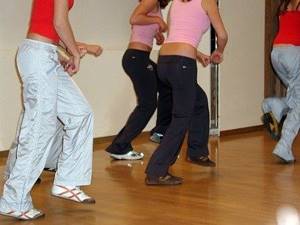
Step aerobics involves a set of health-improving exercises based on basic ligaments, raising and lowering the legs to rhythmic music. During the classes, special step platforms are used (the height can be adjusted individually), which help to carry out “stepping” movements in different ways.
A typical session lasts approximately 50-60 minutes; during this period, with an average level of exercise, it is possible to burn up to 600 calories. The main emphasis in training is on working the muscles of the legs, arms and shoulders. Thanks to its intense pace, step aerobics is one of the most effective types of cardio exercise: with its help, you can harmoniously develop muscles and burn a huge number of extra calories.
